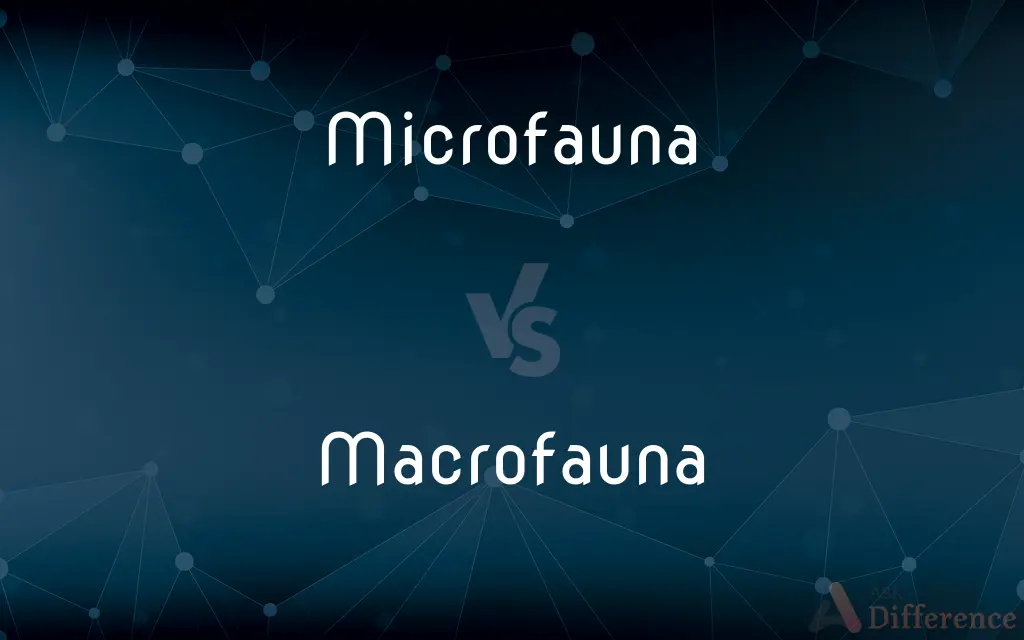Microfauna vs. Macrofauna — What's the Difference?
By Urooj Arif & Maham Liaqat — Updated on April 22, 2024
Microfauna are microscopic organisms, often less than 0.1 mm in size, thriving mostly in soil or aquatic environments; macrofauna, larger than 0.5 mm, are visible to the naked eye, including earthworms and larger insects.

Difference Between Microfauna and Macrofauna
Table of Contents
ADVERTISEMENT
Key Differences
Microfauna, typically smaller than 0.1 mm, primarily include protozoans and nematodes, influencing soil chemistry and structure through their biological processes. Macrofauna, on the other hand, are larger soil organisms like earthworms and beetles, playing crucial roles in aeration and decomposition, visibly altering their ecosystems more directly.
In ecological studies, microfauna's role is often studied at the microbial interaction level, affecting nutrient cycling on a microscale. Whereas macrofauna are studied for their physical impact on the environment, such as soil mixing and the creation of microhabitats for other organisms.
Microfauna, due to their size, are usually limited to water-filled pore spaces in soil or aquatic environments, relying on film water for mobility and survival. Macrofauna, however, can inhabit broader and more varied environments, including dry land surfaces, burrowing deeply into soil.
The study of microfauna requires specialized microscopic equipment, making their study more technically demanding. In contrast, macrofauna can often be observed and studied with minimal equipment, making them more accessible for educational and research purposes.
Reproductive strategies also differ; many microfauna reproduce rapidly, with some species capable of asexual reproduction, leading to quick population changes. Macrofauna typically have slower reproductive cycles, with sexual reproduction being the norm, influencing longer-term ecological dynamics.
ADVERTISEMENT
Comparison Chart
Size
Typically < 0.1 mm
Typically > 0.5 mm
Habitat
Mainly soil and aquatic environments
Varied, including dry and moist soil
Visibility
Microscopic, invisible to the naked eye
Visible to the naked eye
Study Equipment
Requires microscopes for observation
Can be observed with minimal equipment
Reproductive Strategies
Often rapid and includes asexual reproduction
Slower, mainly sexual reproduction
Compare with Definitions
Microfauna
Tiny organisms, often microscopic, living predominantly in aquatic or soil environments.
Microfauna like tardigrades can survive extreme conditions by entering a desiccated state.
Macrofauna
Organisms contributing to the mechanical alteration of their habitats, such as mixing soil layers.
The presence of macrofauna is crucial for maintaining soil structure.
Microfauna
Microscopic biotic elements contributing significantly to the biodiversity and functioning of ecosystems.
Studying microfauna provides insights into soil health and nutrient cycles.
Macrofauna
Animals large enough to be seen without magnification, often influencing their habitats physically.
The burrowing activities of macrofauna help aerate the soil.
Microfauna
Very small, often unicellular organisms involved in basic ecological processes such as decomposition.
Microfauna are essential for breaking down complex organic compounds in wetlands.
Macrofauna
Larger, visible organisms that inhabit the soil or other environments, playing key roles in ecological dynamics.
Macrofauna such as earthworms are vital for enhancing soil fertility.
Microfauna
Biological indicators used to assess environmental health, particularly in aquatic systems.
The presence of certain microfauna in water bodies indicates good ecological quality.
Macrofauna
Larger biotic components that can be manually handled and studied in ecological research.
Researchers often collect macrofauna to study population dynamics and predator-prey relationships.
Microfauna
Organisms invisible to the naked eye, requiring magnification for study and observation.
Scientists use electron microscopes to observe the intricate details of microfauna.
Macrofauna
Important participants in the food web, acting as prey and predators within ecosystems.
Macrofauna serve as critical food sources for a variety of higher predators.
Microfauna
Microfauna (Ancient Greek mikros "small" + New Latin fauna "animal") refers to microscopic animals and organisms that exhibit animal-like qualities. Microfauna are represented in the animal kingdom (e.g., nematodes, small arthropods) and the protist kingdom (i.e., protozoans).
Macrofauna
Macroscopic animals of soil or benthic sediments that are greater than about 1 or 2 millimeters in size, such as earthworms or polychaetes.
Microfauna
Microscopic or very small organisms, such as protozoans, that live in soil or benthic sediments.
Macrofauna
Any large animal that is not quite large enough to be considered megafauna, but larger than microfauna. Some include larger species of insects and annelids in this group.
Microfauna
The smallest of the faunal size divisions, including mainly microorganisms but also sometimes applied to the tiniest species of animal groups such as ticks, insects, etc.
Common Curiosities
What are some examples of macrofauna?
Examples include earthworms, beetles, and larger soil insects.
What defines an organism as microfauna?
Microfauna are defined primarily by their size, being less than 0.1 mm and typically microscopic.
Can microfauna be seen with the naked eye?
No, microfauna are too small to be seen without the aid of a microscope.
How do macrofauna contribute to soil health?
Macrofauna contribute by aerating the soil, enhancing nutrient availability, and aiding in decomposition.
How do microfauna and macrofauna differ in their reproductive strategies?
Microfauna often reproduce rapidly and may employ asexual reproduction, whereas macrofauna typically reproduce sexually and at a slower rate.
Why are macrofauna easier to study than microfauna?
Macrofauna are visible to the naked eye and require less specialized equipment for observation and study.
Are microfauna important for ecosystem health?
Yes, microfauna play a critical role in nutrient cycling and maintaining soil and aquatic ecosystem health.
Are microfauna affected by changes in environmental conditions?
Yes, microfauna are sensitive to environmental changes, which can significantly impact their populations and roles in ecosystems.
What makes macrofauna visible to the naked eye?
Macrofauna are larger than 0.5 mm, making them visible without any magnification.
How do the habitats of microfauna and macrofauna differ?
Microfauna are mostly confined to moist or aquatic environments, while macrofauna inhabit a wider range of environments, including dry soils.
What tools are needed to study microfauna?
Studying microfauna typically requires microscopes and sometimes more advanced imaging technologies.
Can the study of macrofauna help in environmental conservation?
Yes, studying macrofauna helps in understanding ecosystem functions and aids in conservation efforts.
What role do microfauna play in water quality assessment?
Microfauna serve as indicators of water quality, with their presence and diversity reflecting the health of aquatic ecosystems.
What is the ecological impact of microfauna on soil?
Microfauna affect soil properties and fertility through their roles in the decomposition process and nutrient cycling.
How do macrofauna affect other organisms in their habitat?
Macrofauna create microhabitats and influence the distribution and abundance of other soil organisms.
Share Your Discovery

Previous Comparison
Immigrant vs. Nonimmigrant
Next Comparison
Trolling vs. TrawlingAuthor Spotlight
Written by
Urooj ArifUrooj is a skilled content writer at Ask Difference, known for her exceptional ability to simplify complex topics into engaging and informative content. With a passion for research and a flair for clear, concise writing, she consistently delivers articles that resonate with our diverse audience.
Co-written by
Maham Liaqat













































